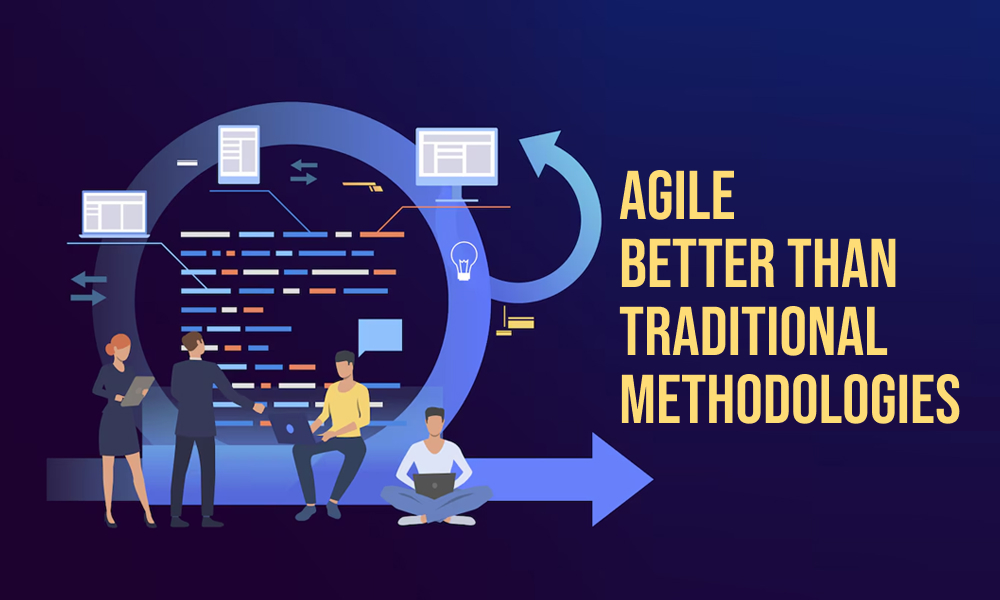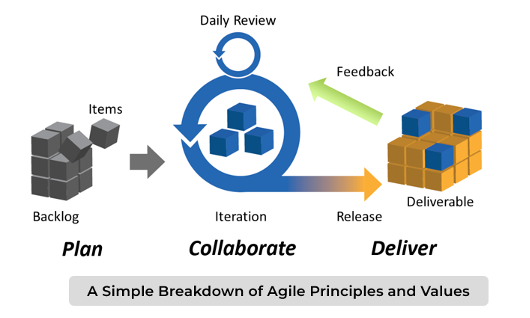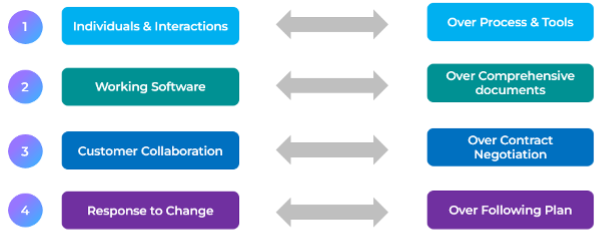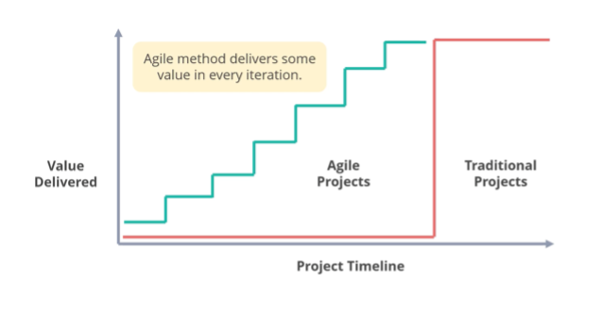table of content
- Introduction
- What is Agile Methodology
- Life Cycle of Agile Methodology
- What is Agile Manifesto?
- Agile Value
- Agile Principle.
- Why Agile over traditional Methodology?
- Common Framework used in Agile Methodology
- Scrum
- Kanban
- Lean
- Extreme Programming (XP)
- Conclusion
- How CodeStore Technologies Helps You to Stay Ahead with Project Management Trends?
- FAQs
Why Is Agile Better Than Traditional Methodologies for Business Growth?

Introduction
Being ahead of the curve in the fast-paced business world of today calls for embracing change, adapting quickly, and delivering outcomes more quickly than ever. Traditional approaches to doing things will not keep up with evolving demands, which will leave teams feel trapped in systems that do not allow for swift change. Would it be possible to increase productivity, encourage teamwork, and drive creativity while keeping customers at the leading edge?
The answer is the agile methodology, which provides companies with an iterative, client-centric approach that encourages collaboration and continuous growth. In this blog, we’ll look at the transformative approach of Agile, its benefits over traditional methods, its core values and principles, and the most popular frameworks.
What is Agile Methodology
Agile is a Mindset. It’s an iteration development process. Agile methodology is a project management framework that breaks projects down into several dynamic phases, commonly known as sprints.
Agile encourages changes and adapts solutions based on input in an ongoing process. It allows teams to efficiently plan, carry out, and improve, which stimulates creativity and speeds up decision-making.
Global giants like Amazon, Google, and Facebook appreciate agile because it guarantees flexibility and exceptional results. Agile is the preferred approach for businesses looking to succeed in the marketplace because it transforms project management by placing a high value on efficiency and adaptability.

Life Cycle of Agile Methodology
Each phase in the Agile methodology process is essential to its smooth operation. Here’s why every step is important:
- Requirements: Companies collect and prioritize client requirements to define project goals and ensure alignment with expectations.
- Planning: A strategic roadmap is created to outline development timelines, iteration cycles, and feature delivery to ensure an efficient, structured workflow.
- Development: The team creates software in rapid and iterative cycles that incorporate feedback and refined features to ensure ongoing improvement.
- Testing: Rigorous testing ensures software quality, functionality, and reliability, and identifies and fixes defects before deployment.
- Deployment: The software is released for user access with seamless functionality and integration into the business ecosystem.
- Maintenance: The software is kept secure, effective, and consistent with evolving customer demands by frequent updates and optimizations.
What is The Agile Manifesto?
The Agile Manifesto was introduced in February 2001. It is a set of statements that outline the core values and principles of Agile approaches. The Agile Manifesto has 12 principles and 4 values.

Agile Value
The Agile Manifesto has four core values:

- Individuals and interactions over processes and tools – Collaboration among the team members is prioritized as it improves efficiency and communication.
- Working software over comprehensive documentation – The delivery of functional software is more crucial than comprehensive documentation.
- Customer collaboration over contract negotiation – Engaging customers throughout the process ensures alignment with their evolving needs.
- Responding to change over following a plan – Agile embraces flexibility so that teams can adapt seamlessly to new requirements.
Agile is an iterative methodology that emphasizes continuous and incremental delivery through continuous sprints. These values foster adjustments to plan, scope, and design that align to the business. Agile is, therefore, preferred by current businesses since it reduces delays and produces high-quality solutions effectively in quickly shifting conditions.
Agile Principle
- Early Value Delivery: Our highest priority is to satisfy the customer through early and continuous delivery of valuable software.
- Change for good: Changes are encouraged at any point in the development process. Agile methodologies embrace change to offer businesses a competitive edge.
- Weeks not Months: Deliver operating software frequently, preferably within a shorter timeframe of two weeks to a few months.
- Partner with Business: Businesspeople and developers must work together daily throughout the project.
- Motivation & Trust: Build projects around motivated people. Give them the necessary environment, support, and trust them to complete their duty.
- Direct & Open Communication: Face-to-face interaction is the most effective and efficient way to interact with a development team.
- Show & Tell: The most important indicator of progress is working software.
- Keep it Steady: Agile processes promote sustainable development. Sponsors, developers, and users should be able to maintain a constant pace indefinitely.
- Never Compromise Quality: Ongoing attention to quality design and technical proficiency improves agility.
- Keep It Simple: It is vital to practice simplicity, which is the skill of maximizing the amount of effort that is not done.
- Empower the Team: The finest architecture, requirements, and designs come from self-organizing teams.
- Continuous Improvement: The team regularly evaluates approaches to improving its effectiveness and modifies its behavior accordingly.
Why Agile over Traditional Methodology?
Traditional project management is difficult to adjust to because of its strict structure and established schedules. Whereas Agile works best in dynamic situations and provides flexibility and quicker delivery. Here’s why Agile is the better option:

- Ideal for Scaling Projects: Agile is ideal for projects with unclear start requirements, as it allows teams to modify the scope according to changing business needs.
- Adaptability: Agile helps businesses in the technology industries by enabling them to quickly adapt to changing market trends.
- Continuous Customer Collaboration: Agile encourages continuous feedback to guarantee alignment, in contrast to traditional approaches that only involve customers at the beginning and finish.
- Rapid Prototyping & Frequent Deliveries: Agile allows for early prototypes and continual iterations, which reduces time to market and ensures the final product fulfills expectations.
- Minimized Project Risks: Regular testing and feedback loops prevent costly solutions and large-scale failures by locating problems early.
- Faster Time-to-Market: Agile delivers working product versions every two to four weeks for faster and more tangible progress.
- Encourages Innovation: Daily collaboration and brainstorming drive creativity, so teams can develop cutting-edge solutions efficiently.
Agile is a better option than traditional methods because of its flexibility, customer-centric approach, and iterative development process, which guarantee effective, risk-free, and creative project execution.
Common Framework Used in Agile Methodology
There are many frameworks used in agile methodology, here are some of the most preferred frameworks used by the company to drive business growth:

Scrum
Scrum is a branch of Agile that focuses on structured iterations known as “sprints.” It manages projects well by using certain roles such as Scrum Master, Product Owner, Development Team, etc., and practices like Daily Standups, Sprint Planning, Sprint Retrospective, and many more.
Key Features:
- Roles: Scrum Master, Product Owner, Development Team.
- Sprints: Short, focused cycles (usually 1-4 weeks).
- Daily Standups: Short daily meetings to update on progress and identify obstacles.
When to Use: Best for teams that work on complex, evolving projects and require frequent feedback and rapid iteration.
Example: Software development, product development teams.
Kanban
Another Agile-based approach that focuses on managing and visualizing workflow is called Kanban. It helps teams prioritize and streamline operations by using boards, either physical or digital, to display tasks and their status.
Key Features:
- Visual Boards: Tasks are visualized as cards on a board, often divided into columns like “To Do,” “In Progress,” and “Done.”
- Continuous Flow: Unlike Scrum, “sprints” do not have a set duration; instead, tasks flow continuously through stages.
- Work-in-Progress Limits: Helps prevent overloading team members by limiting how many tasks can be worked on at once.
When to Use: Great for teams that require flexibility and are focused on continuous delivery or process improvement (e.g., customer service teams, marketing).
Example: Software maintenance, service-oriented teams
Lean
Lean emphasizes maximizing value through process improvement and minimizing inefficiencies (time, resources, or effort). It is commonly utilized in manufacturing but has also been applied to other industries.
Key Features:
- Waste Reduction: Focus on streamlining processes and removing inefficiencies.
- Value Stream Mapping: Analyzing and improving the flow of value in the project.
- Continuous Improvement: Constantly refining and optimizing processes.
When to Use: Ideal for projects or organizations focused on improving efficiency and minimizing waste (e.g., manufacturing, operations).
Example: Automotive manufacturing, supply chain optimization.
Extreme Programming (XP)
XP is an Agile technique that combines frequent releases and continuous feedback to enhance software quality and responsiveness to changing client needs.
Key Features:
- Frequent Releases: Delivering software in short, frequent iterations (like sprints).
- Pair Programming: Developers work in pairs, with one writing code and the other reviewing and providing feedback.
- Test-Driven Development: Writing automated tests before writing the actual code.
When to Use: Best for software development projects that need rapid iterations, continuous feedback, and high-quality code.
Example: Software development teams with a focus on high-quality, bug-free code.
Conclusion
Businesses may thrive in today’s business environment by using an agile approach, which offers them the flexibility, speed, and customer-driven interaction they need. This iterative approach can be used by any business because it encourages creativity inside the organization, increases productivity, reduces process risk, and improves team effectiveness. Businesses have more control over how they lead, complete projects faster, and remain ahead of changing expectations when they use Agile frameworks like Scrum, Kanban, Lean, or XP.
Are you ready to achieve more success with Agile project management? CodeStore focuses on using Agile approaches to boost productivity, creativity, and customer pleasure. Get in contact with us immediately to start! Come see us at codestoresolutions.com.
How CodeStore Technologies Helps You to Stay Ahead with Project Management Trends?
CodeStore is an offshore custom software development company based out of India. Our expertise lies in creating high-quality, innovative custom software solutions for businesses of all sizes.
We prioritize your app’s user experience through our exceptional development practices. We have assisted various startups in enhancing their business through our digital product development.
What are you waiting for? Get in touch with our expert now to discuss your app idea and get started!
FAQs
What is Agile, and how does CodeStore Solutions implement it in software development?
Agile methodology facilitates iterative development, collaboration, and adaptability. CodeStore Solutions uses Agile software development methodology to provide customer-focused solutions, continuous improvement, and rapid delivery.
What Agile frameworks does CodeStore Solutions follow?
We leverage Scrum and Agile methodology, Kanban Agile methodology, and hybrid approaches to optimize workflows, enhance productivity, and align with diverse project needs.
How does Agile improve project efficiency?
Through iterative cycles, ongoing feedback, and adaptive planning, the agile management methodology increases productivity and guarantees better product quality, quicker delivery, and lower risks.
How do Agile sprints work in project execution?
The Scrum Agile methodology’s structures are organized into sprints, which are brief, time-limited development cycles that enable teams to set targets, make fast modifications, and produce incremental progress.
How does CodeStore Solutions ensure client involvement in Agile projects?
Our agile approach process ensures transparency and alignment with business goals through collaborative planning, feedback loops, and regular sprint reviews.
Can Agile be used for both small and large-scale projects?
Yes, agile software development methodologies scale well for projects of different sizes and offer flexibility, efficiency, and continuous delivery across a variety of business goals.
How does Agile handle changing requirements during a project?
Agile embraces change through iterative planning, frequent reassessments, and flexible execution to guarantee that shifting business needs are successfully met.
What are the benefits of Agile project management for businesses?
The agile management methodology enhances flexibility, speeds up time-to-market, prevents risks, promotes collaboration, and boosts customer happiness.
How does CodeStore Solutions manage Agile project communication?
We use the Agile Scrum development methodology, which includes daily stand-ups, sprint planning, and real-time collaboration tools, to ensure clear, efficient, and transparent communication.
Why should businesses choose CodeStore Solutions for Agile-driven software development?
CodeStore Solutions is one of the leaders in Agile development. We provide scalable, high-quality, cost-effective solutions with adaptable execution and direct relationships with clients.



